Text
Learn 3NPS Smarter: Hungarian Minor Vs Harmonic Minor
Hi all! Today we'll take a look at a cousin of Harmonic Minor: The Hungarian Minor scale! ;) The difference is 1 note but the fun part of this scale is 2 leaps of 2 half-steps! Harmonic Minor has 1 such leap. By contrast, Natural Minor scale and Melodic Minor scale has 0 such leaps, so it's quite a different sensation for your fretting hand :)
Its characteristic interval is #4 which is a tritone. This raised 4th results in 2 consecutive half-steps which introduces natural chromaticism. The takeaway here is that if you like the dark sounding Harmonic Minor then you will appreciate this one as well! ;)


Download here
Soon I'll publish a variation with beginner-friendly note names as well. Keep an eye on the website for updates! :)
If you find this content helpful, I'd appreciate any kind of support—a Like, a share, or a comment—everything helps! Have fun learning! Oleg
#guitars#learnguitaronline#guitarsdaily#talented#music_theory#beginnerelessons#learnmusicproduction#study#acousticguitarist#musicianposter#musicposter
0 notes
Photo

5 Reasons to Learn Music Theory - Five good reasons why music theory is a must if you expect to perfect your musical talent.
2 notes
·
View notes
Text
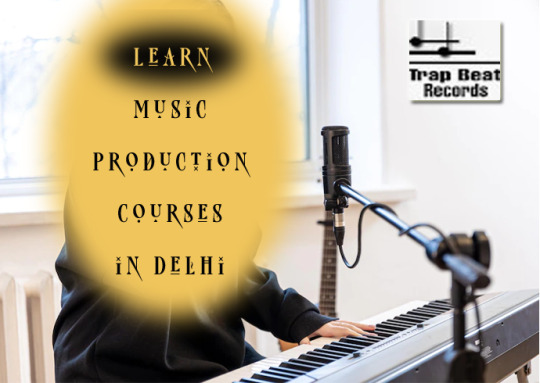
#Trap Beat Records Music production courses in Delhi provided a simple#suitable and according to your time and duration that includes Music_Theory. Learn Advanced 𝙈𝙪𝙨𝙞𝙘 𝙋𝙧𝙤𝙙𝙪𝙘𝙩𝙞𝙤𝙣 𝘼𝙘𝙖𝙙𝙚𝙢𝙮 𝙄𝙣 𝘿𝙚𝙡𝙝𝙞 at best pric#music_production#production#delhi#musicproduction
1 note
·
View note
Text
EARTHSIDE @earthsideband #AllWeKnew #AndEverLoved Feat. #BaardKolstad #Leprous @MLG_Rocks @music_theories
EARTHSIDE @earthsideband #AllWeKnew #AndEverLoved Feat. #BaardKolstad #Leprous @MLG_Rocks @music_theories
The evocative and ever-engrossing post-rock New England collective EARTHSIDE have released a video for their new orchestral/prog single “All We Knew And Ever Loved” and it features Baard Kolstad, the drummer from Norwegian rockers Leprous. ‘All We Knew and Ever Loved‘ (out now via Mascot Label Group, video shared below) employs probably the most apocalyptic sound in the entire world (the track…

View On WordPress
#All We Knew and Ever Loved#Baard Kolstad#Ben Shanbrom#diabolically enormous#EARTHSIDE#earthsideband#Goya#goya black painting#interdimensional hellzone#Leprous#neil mach#neilmach#perturbations#raw ramp#rawramp#seismic subduction
1 note
·
View note
Text
Music Theory Blog by Sheenagh Shannon (MK)
My name is Sheenagh Shannon. I’m an 18-year-old singer/songwriter currently studying music performance. In this blog I’m going to break down the basic principles of music theory to hopefully help any readers gain a better understanding of the inner-workings of the music we love and listen to.

Scales
I’d like to begin by explaining what scales are and how they work. The pictures I will be showing have music written on what is called a stave, and included on the stave is either a bass or treble clef (treble clef being higher, and bass clef being lower.) The notes in the treble clef start with E on the bottom line and ascend from there, whereas the notes in the bass clef start with B and ascend from there.
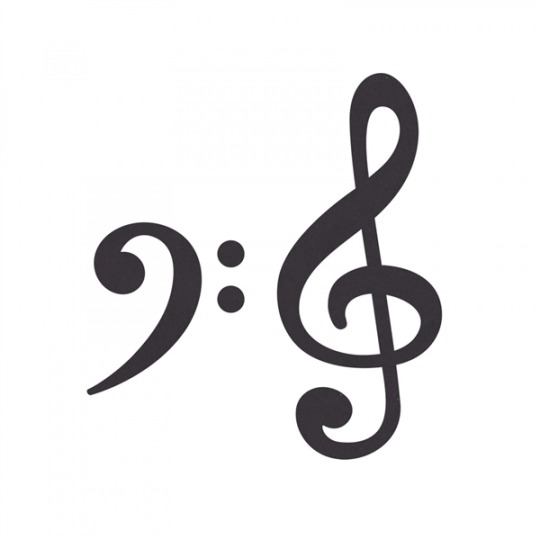
(Left is the bass clef, right is treble clef.)
A scale is a group of notes that are arranged by ascending or descending order of pitch. In an ascending scale, each note is higher in pitch than the last one and in a descending scale, each note is lower in pitch than the last one. I will explore the two most common types of scales; major and minor.

You must have a note on every single line or space of the stave. One of the most common types of scale is the major scale. These scales are used in an endless variety of songs we listen to. Major scales are defined by the order of which semitones and tones occur. Semitones are whole steps and half steps, and their combination specifies how a scale should be interpreted. For example, the major scale is this:
Tone – Tone – Semitone – Tone – Tone – Tone – Semitone
Or in whole steps and half steps it would look like:
Whole – Whole – Half – Whole – Whole – Whole – Half

This formula can be used to form a major scale starting on any note. Major keys are often correlated with positive emotions – a good example of how a major key can create an upbeat and joyous mood is a song called ‘Breakfast At Tiffany’s,’ by Deep Blue Something. (https://www.youtube.com/watch?v=QSgJ5On8Zso)
The second type of scale I’d like to explain is the minor scale. A minor scale, much like the major scale, also has seven notes but is defined by having a flattened third. This means that the third note on the scales is three semitones above the first note. With major scales, the third note of the scale is situated four semitones above. A seemingly small change, but it makes all the difference!
Tone – Semitone – Tone – Tone – Semitone – Tone – Tone

It’s important to note that there are three different types of minor scale: the natural minor, the harmonic minor, and the melodic minor. Each type of minor scale uses an ever so slightly different formula of semitones and tones, but they all share the minor third in common.
Minor keys are more often associated with music that feels sad or melancholy, but they don’t necessarily have to abide by their assigned moods – minor keys can create intensity, passion, or with the right placement, even joy. Linked is a song called ‘Losing My Religion’ by R.E.M (https://www.youtube.com/watch?v=OKvCV8MFIaw) a song that begins on the chord of A minor. I believe this is a good example of what a ‘minor’ song sounds like.
Modes
Next, I’d like to discuss modes. Modes are a series of seven musical scales each with definitive qualities and varying sounds. Their names are:
Ionian
Dorian
Phrygian
Lydian
Mixolydian
Aeolian
Locrian
Each of these scales are a type of diatonic scale, which means they have seven notes and have two intervals that are semitones (half steps) and five intervals that are tones (whole steps.) The modes can also be split into two types, major and minor modes. The three major modes are Lydian, Ionian and Mixolydian and the four minor modes are Dorian, Aeolian, Phrygian and Locrian, although it is important to note that the Locrian mode is typically defined as a diminished scale. I’m going to give a couple of examples to show how modes work.
Ionian Mode

As shown above, the Ionian mode is exactly the same as the C major scale with no sharps or flats. It’s just another name for it!
Mixolydian Mode

The only difference between this mode and the Ionian mode is that it has a flattened 7th note as shown above. A song that uses this mode is a song called ‘Wicked Game’ by Chris Isaak (https://www.youtube.com/watch?v=aid2vMbCNP8) a song that I personally love and listen to quite often. The song is characterized by its haunting and sorrowfully conflicted tone, which exemplifies how modes can be used to create very specific moods or feelings.
Lydian Mode

The last mode I’m going to show you is called the Lydian mode. It’s the brightest sounding of the modes - quite like the Ionian mode, except it contains a raised fourth note. To play a Lydian scale we sharpen the fourth note of the scale. A song that uses this mode is a song called ‘Flying in a Blue Dream’ by Joe Satriani. (https://www.youtube.com/watch?v=SINl5JY7LhI)
Chords
Chords are the vertical arrangement of notes from a scale. Many people define chords as several notes played simultaneously. Let’s begin with examples of the most basic chord - the triad.
The triad is a class of chords, specifically three-note chords formed by this formula: 1-3-5 or root, third, fifth. There are four kinds:

The major is consonant; the minor is less consonant, but still largely so on most occasions. The augmented chord is very dissonant, and the diminished chord is incredibly dissonant because it contains a tritone (an augmented fourth, or on this occasion, diminished fifth.) This is the basic principle of how chords are formed and what they are. Most songs in existence are built upon a series of chords.
Triads are often extended with some form of the seventh to form a seventh chord. When a chord is called a seventh chord, usually the dominant seventh is meant, which is a major triad with a minor seventh. Because all sevenths are dissonant intervals, any seventh chord is dissonant, because all sevenths are dissonant intervals. A seventh chord is far tenser than a major or minor chord. Jazz music, for example, is a genre that uses seventh chords quite consistently and often seems to treat them as consonant.
Keys
In music, the key identifies the tonal centre of a song. This tonal centre is a note that the whole song revolves around, and each note in the song gravitates towards that home base note. If a song is in the key of C, then each note in the song gravitates towards a C. Below is a list of the 12 keys of music. Key of C Key of Db / C# (en-harmonic keys) Key of D Key of Eb Key of E Key of F Key of Gb / Key of F# (en-harmonic keys) Key of G Key of Ab Key of A Key of Bb Key of B / Key of Cb (en-harmonic keys)

Key signatures can provide an idea as to what key a song is written in. Key signatures appear directly after the clef signs and will tell you what sharps or flats will appear in a song. The number of sharps or flats in the key signature can give you a clue as to what key a song is in. For example, if a song has no sharps or flats in the key signature, the song may be in the key of C. If a song has one sharp in the key signature, it may be in the key of G. I’ve included a chart of key signatures to help explain this principle better.
Note Lengths
Each note written on the stave has a duration as well as pitch. In music notation, a note value indicates the duration of the note. It is the design of the note that tells you its duration, in the same way as the position on the staff tells you the pitch.
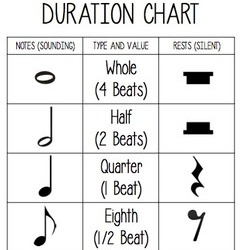
This chart should indicate a clear and simple analysis of how note lengths work. For example, if a song is in 4/4, it would look something like this:

Time Signatures
In music, a time signature alerts you to the meter of the piece that you’re playing. The two numbers in the time signature tell you how many beats are in each measure of music. A piece with a time signature of 4/4 has four quarter note beats; each measure with a 3/4 meter has three quarter note beats; and each measure of 2/4 time has two quarter note beats. The most common time signatures you will come across are:
4/4 - Common time
3/4 - Waltz time
2/4 - March time
6/8 time
The most common meter in music is 4/4. In 4/4, the stacked numbers tell you that each measure contains four quarter note beats. So, to count 4/4 meter, if you tap the beat each time, you would be tapping the equivalent of one quarter note. ¾ is the second most common meter, and each measure has three quarter note beats. In 3/4 time, beat 1 of each measure is the downbeat, and beats 2 and 3 are the upbeats. It’s quite common amongst country music.
Once you start listening closely, you can hear the difference between time signatures. A famous song that uses 4/4 is a song called ‘Runaway Train’ by Soul Asylum (https://www.youtube.com/watch?v=OzzKBxlIiEQ.) If you count the beats you can hear the difference between that song and a song like ‘Strawberry Wine’ by Deana Carter (https://www.youtube.com/watch?v=tdWV7PpeTVA) for example.
My Transcription

I’ve transcribed a verse and a chorus from a song called ‘Molly’s Lips,’ by Nirvana (https://www.youtube.com/watch?v=f76GsOBxUg0)
I’ve chosen this song because it’s simple, to be perfectly honest! It gives a good, clear example of what a transcription looks like.
All References And Sources Used:
https://en.wikibooks.org/wiki/Music_Theory/Chords
http://www.zebrakeys.com/lessons/beginner/musictheory/?id=12
https://www.uberchord.com/blog/music-theory-chords/
https://www.dummies.com/art-center/music/piano/common-music-time-signatures/
https://www.libertyparkmusic.com/musical-time-signatures/
https://www.essential-music-theory.com/music-note.html
I hope reading this blog has been as informative as it has been interesting. Until next time!
Sheenagh :)
1 note
·
View note
Text
Rick Beato: Why Postmodernism In Music Is Bad (Sucks) - YouTube
Rick Beato: Why Postmodernism In Music Is Bad (Sucks) – YouTube
Rick Beato’s above linked YouTube channel was kindly brought to my attention by Dietmar Liehr, a prolific Jazz guitarist, bassist, occasional drummer, session host, sideman and entrepreneurial man of many hats – as in: roles. While Beato sounds a bit too dogmatic to my ears sometimes, I think he has some excellent points with…
View On WordPress
#beato#composing#film#film_music#harmony#modern_composers#music#music_theory#rick_beato#voice_leading
0 notes
Link
Here is yet another interesting article that doesn’t really have much context in regards to discussion in class or the readings from “Futuring” specifically, but it did throw out the window a previous misconception I had about the reaches of current trends in educational VR. Jam Studio (currently being showcased by one of the trustier news websites centering on VR technologies and content innovation) is primarily a music composition app for VR users, but the recent release of an education and healthcare edition poses interesting potential within music education, such as music theory in connection with actual musical practice, therapeutic musical exercises and wellness, etc.
Prior to doing my research for this course, I had made note of the skepticism widespread audiences had in regards to VR education--after all, it’s taken this long for VR to make it the mainstream, and it still hadn’t kicked off as a massive universal form of entertainment, so what sort of future would it have on education anyway? I had made the assumption that most VR experiences in the classroom would be relegated to STEM courses (the science and maths), and while I have seen some interesting VR apps and experiences in regards to social learning and history, this is the first actual VR app I’ve seen for Music Education. I would be especially interested to see the healthcare applications spoken of in this article , how they would play out in the app and how they would be used by counselors and health experts outside of the classroom experience as well.
#VR#classroom#education#Newhouse#music#music_theory#fine_arts#healthcare#unexpected#digital_disruptor?
0 notes
Text
New Release: Walter Trout - Ride
New Release: Walter Trout - Ride @waltertrout @MLG_Rocks @ProvogueRecords @music_theories
Walter Trout – Ride Walter Trout – Ride Formats: CD – LP – Colored LP and Digital Label: Provogue – Mascot Label Group Release: 2022 Release date: August 19, 2022 However fast or far a man travels, he can never truly outrun his past. Walter Trout knows this better than anyone. As he embarked on his 30th solo album, ‘Ride,’ the iconic US blues-rock guitarist found himself eyeing the horizon…
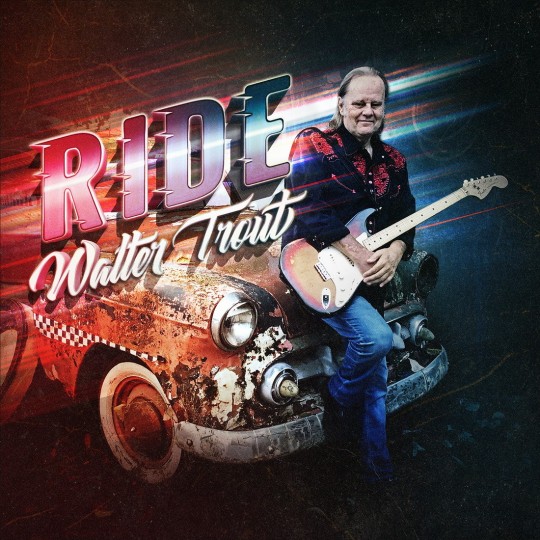
View On WordPress
0 notes
Text
3NPS Made Easy: Phrygian Dominant Vs Phrygian
Hi all!
Today we're comparing the 5th mode of Harmonic Minor: Phrygian Dominant which is loved so much by Yngwie Malmsteen! By now you should be able to see the "pattern" that everything builds gradually, especially if you compare things side-by-side! E.g. from Minor to Phrygian is 1 note change, and from Phrygian to Phrygian Dominant is also 1 note change.


Download here
Tomorrow I will publish a variation with beginner-friendly note names as well, so check my website later!
If you find this content helpful, I'd appreciate any kind of support—a Like, a share, or a comment—everything helps! Have fun learning! Oleg
#guitarra#guitarlessonsonline#guitarlove#skilled#solo#music_theory#songproduction#acousticguitars#musiceducation#musicianposter#musicposter
1 note
·
View note
Text
Paul Gilbert - Behold Electric Guitar
Paul Gilbert - Behold Electric Guitar // @PaulGilbertRock @MLG_Rocks @music_theories
PAUL GILBERT – ‘BEHOLD ELECTRIC GUITAR’ New album from master guitarist out May 17, 2019 on Music Theories Recordings
Paul Gilbert returns to Music Theories Recordings with Behold Electric Guitar, featuring 12 new original songs. Most songs are instrumental, except for his poem, “A Herd of Turtles”, where Paul opted his best Liverpudlian accent to recite his poem of hope, and inserted some…
View On WordPress
0 notes
Text

Which is the Best Music Production Academic in Delhi India? Trap Beat Records Music production courses in Delhi provided a simple, suitable and according to your time and duration that includes Music_Theory. Learn Advanced 𝙈𝙪𝙨𝙞𝙘 𝙋𝙧𝙤𝙙𝙪𝙘𝙩𝙞𝙤𝙣 courses 𝙄𝙣 𝘿𝙚𝙡𝙝𝙞 at best price in Delhi NCR. https://g.page/trapbeatrecordsdelhi?share
music_production #production #delhi #musicproduction
0 notes
Text
JAN AKKERMAN @JanAkkerman12 — #CloseBeauty #AlbumReview @music_theories @MLG_Rocks
JAN AKKERMAN @JanAkkerman12 — #CloseBeauty #AlbumReview @music_theories @MLG_Rocks
Jan Akkerrman releases a “full and lustrous album of beauteous moments & bountiful charm…”
JAN AKKERMAN is the Dutch guitarist who co-founded FOCUS back in the late 60s with yodeling keyboards-wiz and incomparable flautist Thijs van Leer.
In 1969 the outfit, that also included Hans Cleuver (drummer) and Martijn Dresden (bassist) was the pit band for the Dutch theatrical production of musical Hair
View On WordPress
#author neil mach#bass-ostinato#Beyond The Horizon#brings out new album#Close Beauty#Coen Molenaar#contribution to Dutch music#David de Marez Oyens#does jan akkerman still play guitar#flamenco fantasique#FOCUS#Focus guitarist#Golden Harp Award#Hair#Hans Cleuver#in 2019#instrumental rock#is jan akkerman still playing?#is jan akkerman still with Focus?#Jan Akkerman#Jazz fusion#Marijn van den Berg#Martijn Dresden#Mascot Label Group#Mike Oldfield#Moving Waves#neil mach#neilmach#Netherlands#North Sea Jazz
0 notes
Text
3NPS patterns: Dorian Vs Minor (minimalistic design)
I've recently published 3NPS: Dorian vs Minor with notes names. But this reference has a minimalistic design with no extra guidance and with scale notes shown as empty shapes providing a clean, uncluttered look. It's perfect for seasoned guitar players or simply those who want extra focus! Choose whatever variation helps you most at any given moment, that's why I'm making them in several flavors :)


Features and benefits
Minimalistic design with scale notes shown as empty shapes for a clean look
Learn new scales faster by comparing them with a similar one you already know
No need to memorize a whole new scale pattern—just learn the changes
All patterns remain strictly 3-notes-per-string even after the changes
Visual side-by-side comparison of patterns with relevant highlighting only
Full set of 7 3NPS patterns
Movable patterns to any root note of your choice
Learn the characteristic note of Dorian as a bonus
Download here
When you follow the link you'll also find a related variation of the same reference with note names and generic intervals!
If you find this content helpful, I'd appreciate any kind of support—a Like, a share, or a comment—everything helps! Have fun learning! Oleg
#guitarra#guitarlessonsonline#guitarlove#skilled#solo#music_theory#songproduction#acousticguitars#musiceducation#musicianposter#musicposter
0 notes
Text
Learn Dorian 3NPS Patterns Easy Using Scale You Know
Do you feel like there's no end to the number of guitar scale patterns and every other one you find seems to be different and unrelated, even though they have similar titles?
In this reference chart we're focusing on the concept of learning something new by comparing it with a similar alternative you already know. In our case, we are comparing Dorian to the Natural minor scale, side-by-side, note-by-note, highlighting the changes. You'll see how a "new" pattern is derived from an existing pattern, and from that point onwards you'll not think of the new pattern as "unrelated" anymore!
The best part? You don't have to memorize a whole new scale pattern. Instead, you only need to learn the changes. Our ultimate goal is for you to think in terms of "this new scale is like this other one I know except for one small change". Once you make this connection, you'll have nailed the concept!
This reference features diagrams with beginner-friendly note names instead of generic intervals and other types of presentation you might not yet be comfortable with.
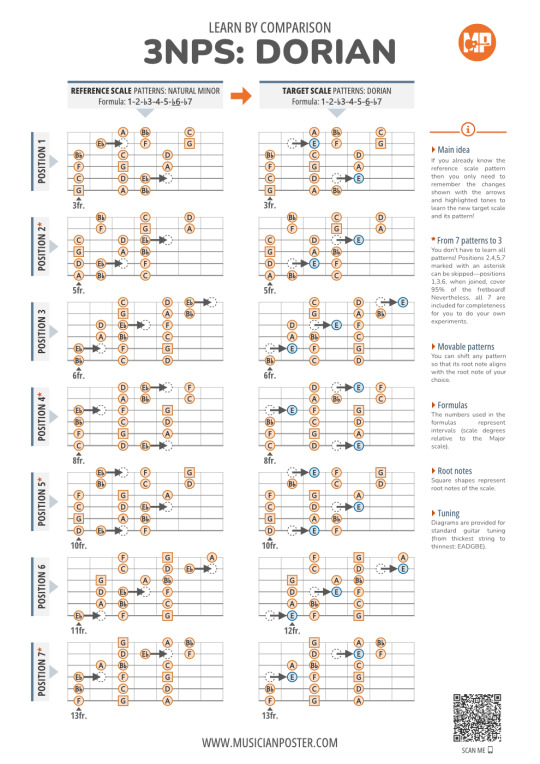
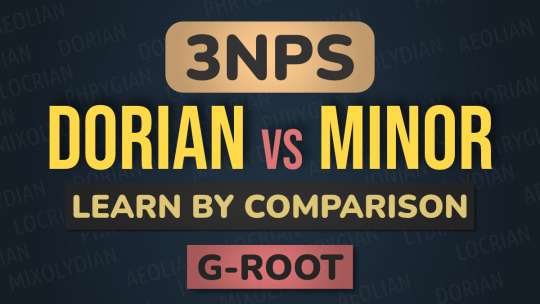
→ Download here
In the near future I will post a variation with generic intervals as well, so check back later!
If you find this content helpful, I'd appreciate any kind of support—a Like, a share, or a comment—everything helps! Have fun learning! Oleg
#guitars#learnguitaronline#guitarsdaily#talented#music_theory#beginnerelessons#learnmusicproduction#study#acousticguitarist#musicianposter#musicposter
0 notes
Text
Cadential Triads for Modes of the Major Scale (as Roman Numerals)
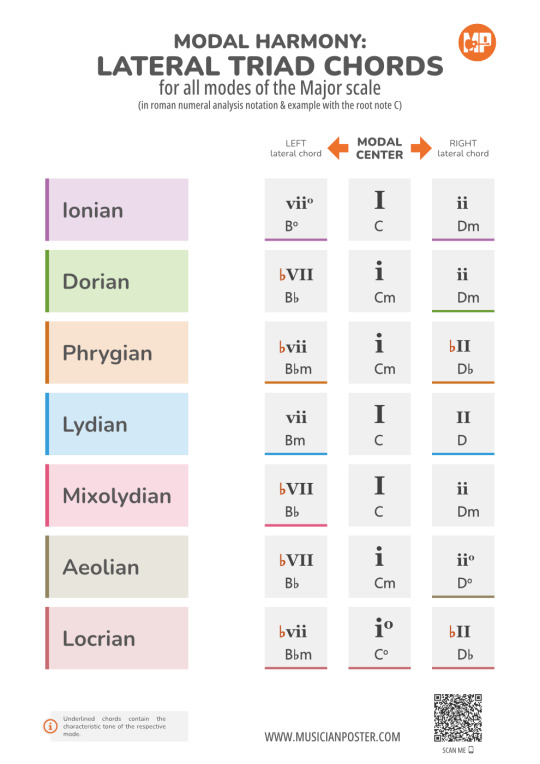
I've recently published a reference for Modal Chords with regular chord names. In this edition the same chords are represented in roman numeral analysis notation. Such notation is first and foremost generic which means that you only have one chart which represents all roots (C, C#, D, etc.) and also it's simply very convenient for quick sight-reading due to its compactness, and we make use of these properties to make them one of the core features of this chart.
Download here
When you follow the link you'll also see a variation of the same reference with individual tones which constitute these chords and the mode's characteristic note is conveniently highlighted so that you know where exactly it is in the chord!
The link above is for triad chords. I will soon be adding a variation for 7ths chords as well. So check back!
If you find this content helpful, I'd appreciate any kind of support—a Like, a share, or a comment—everything helps! Have fun learning! Oleg
#musicman#rockstar#composers#learn#sheetmusic#guitar#music_theory#bassist#pianoteacherlife#musicianposter#musicposter
0 notes